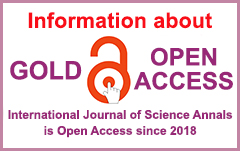| 1 Shyam Shah Medical College, Rewa, India |
Abstract
Background and Aim of Study: Dyslipidemia is a risk factor for cardiovascular disease, and lipid metabolism changes are linked to essential hypertension. The aim of the study: to investigate the significance of lipid parameters, apolipoproteins, and their ratio in predicting cardiovascular disease among individuals with essential hypertension.
Material and Methods: 250 patients with essential hypertension and 250 healthy control subjects were enrolled in this case-control study and their serum lipids and apolipoproteins were analyzed. Differences between cases and controls were examined using independent sample t-test and, a p-value <0.05 was considered significant.
Results: In the essential hypertensive group, fasting blood glucose (FBG), total cholesterol (TC), triglyceride (TG), low-density lipoprotein cholesterol (LDL-C), very low-density lipoprotein cholesterol (VLDL-C), apolipoprotein B100 (Apo B100) and Apo B100/Apo A1 ratio were increased significantly compared to control subjects. Essential hypertensive patients had significantly decreased levels of apolipoprotein A1 (Apo A1) and high-density lipoprotein cholesterol (HDL-C) compared to controls. Moreover, age, body mass index (BMI), FBG, TC, TG, LDL-C, and VLDL-C, as well as the Apo B100/Apo A1 ratio, were significantly positively correlated with both systolic blood pressure (SBP) and diastolic blood pressure (DBP), but HDL-C and Apo A1 were significantly negatively correlated in essential hypertensive subjects. There was a significant positive correlation between apo B100 and SBP in people with essential hypertension. Apo B100 and DBP showed a positive association, however, it was not statistically significant.
Conclusions: Essential hypertensive people with dyslipidemia and an elevated Apo B100/Apo A1 ratio are at an increased risk for the development of cardiovascular disease.
Keywords
essential hypertension, dyslipidemia, apolipoproteins, cardiovascular disease, systolic blood pressure, diastolic blood pressure
References
Albucher, J. F., Ferrieres, J., Ruidavets, J. B., Guiraud-Chaumeil, B., Perret, B. P., & Chollet, F. (2000). Serum lipids in young patients with ischaemic stroke: A case-control study. Journal of Neurology, Neurosurgery, and Psychiatry, 69(1), 29–33. https://doi.org/10.1136/jnnp.69.1.29
AlGhatrif, M., Strait, J. B., Morrell, C. H., Canepa, M., Wright, J., Elango, P., Scuteri, A., Najjar, S. S., Ferrucci, L., & Lakatta, E. G. (2013). Longitudinal trajectories of arterial stiffness and the role of blood pressure: The Baltimore longitudinal study of aging. Hypertension, 62(5), 934–941. https://doi.org/10.1161/HYPERTENSIONAHA.113.01445
Anchala, R., Kannuri, N. K., Pant, H., Khan, H., Franco, O. H., Di Angelantonio, E., & Prabhakaran, D. (2014). Hypertension in India: a systematic review and meta-analysis of prevalence, awareness, and control of hypertension. Journal of Hypertension, 32(6), 1170–1177. https://doi.org/10.1097/HJH.0000000000000146
Barter, P. J., Nicholls, S., Rye, K. A., Anantharamaiah, G. M., Navab, M., & Fogelman, A. M. (2004). Antiinflammatory properties of HDL. Circulation Research, 95(8), 764–772. https://doi.org/10.1161/01.RES.0000146094.59640.13
Bhavani, B. A., Padma, T., Sastry, B. K., & Reddy, N. K. (2003). Plasma lipoprotein (a) levels in patients with untreated essential hypertension. Indian Journal of Human Genetics, 9(2), 65–68. https://www.ijhg.com/article-0971-6866-2003-9-2-65-68-bhavani/
Carmena, R., Duriez, P., & Fruchart, J. C. (2004). Atherogenic lipoprotein particles in atherosclerosis. Circulation, 109(23 Suppl. 1), III2–III7. https://doi.org/10.1161/01.CIR.0000131511.50734.44
Chobanian, A. V., Bakris, G. L., Black, H. R., Cushman, W. C., Green, L. A., Izzo, J. L., Jones, D. W., Materson, B. J., Oparil, S., Wright, J. T., & Roccella, E. J. (2003). The seventh report of the Joint National Committee on prevention, detection, evaluation, and treatment of high blood pressure: the JNC 7 report. JAMA, 289(19), 2560–2572. https://doi.org/10.1001/jama.289.19.2560
Ferreira, I., van de Laar, R. J., Prins, M. H., Twisk, J. W., & Stehouwer, C. D. (2012). Carotid stiffness in young adults: A life-course analysis of its early determinants: the Amsterdam growth and health longitudinal study. Hypertension, 59(1), 54–61. https://doi.org/10.1161/HYPERTENSIONAHA.110.156109
Forouzanfar, M. H., Liu, P., Roth, G. A., Ng, M., Biryukov, S., Marczak, L., Alexander, L., Estep, K., Hassen Abate, K., Akinyemiju, T. F., Ali, R., Alvis-Guzman, N., Azzopardi, P., Banerjee, A., Bärnighausen, T., Basu, A., Bekele, T., Bennett, D. A., Biadgilign, S., Catalá-López, F., … Murray, C. J. (2017). Global burden of hypertension and systolic blood pressure of at least 110 to 115 mm Hg, 1990-2015. JAMA, 317(2), 165–182. https://doi.org/10.1001/jama.2016.19043
Friedewald, W. T., Levy, R. I., & Fredrickson, D. S. (1972). Estimation of the concentration of low-density lipoprotein cholesterol in plasma, without use of the preparative ultracentrifuge. Clinical Chemistry, 18(6), 499–502. https://doi.org/10.1093/clinchem/18.6.499
Gotto, A. M. (2005). Evolving concepts of dyslipidemia, atherosclerosis, and cardiovascular disease: The Louis F. Bishop lecture. Journal of the American College of Cardiology, 46(7), 1219–1224. https://doi.org/10.1016/j.jacc.2005.06.059
Haidari, M., Moghadam, M., Chinicar, M., Ahmadieh, A., & Doosti, M. (2001). Apolipoprotein B as the best predictor of coronary artery disease in Iranian normolipidemic patients. Clinical Biochemistry, 34(2), 149–155. https://doi.org/10.1016/s0009-9120(01)00192-8
Halperin, R. O., Sesso, H. D., Ma, J., Buring, J. E., Stampfer, M. J., & Gaziano, J. M. (2006). Dyslipidemia and the risk of incident hypertension in men. Hypertension, 47(1), 45–50. https://doi.org/10.1161/01.HYP.0000196306.42418.0e
Harvey, J. M., & Beevers, D. G. (1990). Biochemical investigation of hypertension. Annals of Clinical Biochemistry, 27(4), 287–296. https://doi.org/10.1177/000456329002700403
Hausmann, D., Johnson, J. A., Sudhir, K., Mullen, W. L., Friedrich, G., Fitzgerald, P. J., Chou, T. M., Ports, T. A., Kane, J. P., Malloy, M. J., & Yock, P. G. (1996). Angiographically silent atherosclerosis detected by intravascular ultrasound in patients with familial hypercholesterolemia and familial combined hyperlipidemia: Correlation with high density lipoproteins. Journal of the American College of Cardiology, 27(7), 1562–1570. https://doi.org/10.1016/0735-1097(96)00048-4
Hussain, I., Patni, N., & Garg, A. (2019). Lipodystrophies, dyslipidaemias and atherosclerotic cardiovascular disease. Pathology, 51(2), 202–212. https://doi.org/10.1016/j.pathol.2018.11.004
Jia, G., DeMarco, V. G., & Sowers, J. R. (2016). Insulin resistance and hyperinsulinaemia in diabetic cardiomyopathy. Nature Reviews. Endocrinology, 12(3), 144–153. https://doi.org/10.1038/nrendo.2015.216
Kannel, W. B., Castelli, W. P., Gordon, T., & McNamara, P. M. (1971). Serum cholesterol, lipoproteins, and the risk of coronary heart disease. The Framingham study. Annals of Internal Medicine, 74(1), 1–12. https://doi.org/10.7326/0003-4819-74-1-1
Kossaify, A., Garcia, A., Succar, S., Ibrahim, A., Moussallem, N., Kossaify, M., & Grollier, G. (2013). Perspectives on the value of biomarkers in acute cardiac care and implications for strategic management. Biomarker Insights, 8, 115–126. https://doi.org/10.4137/BMI.S12703
Kossaify, A., & Karam, M. (2014). Markers in hypertension: Insights for an enhanced blood pressure management. Journal of Hypertension, 3, 165. https://doi.org/10.4172/2167-1095.1000165
Laaksonen, D. E., Niskanen, L., Nyyssönen, K., Lakka, T. A., Laukkanen, J. A., & Salonen, J. T. (2008). Dyslipidaemia as a predictor of hypertension in middle-aged men. European Heart Journal, 29(20), 2561–2568. https://doi.org/10.1093/eurheartj/ehn061
Lee, S. S., Jhoo, Y. M., Oh, D. J., Lee, M. H., Chung, E. S., & Lee, S. J. (1986). Plasma apolipoproteins and lipids in normal persons and patients with hypertension. The Korean Journal of Internal Medicine, 1(2), 214–221. https://doi.org/10.3904/kjim.1986.1.2.214
Lewis, B. (1986). The appropriate use of diagnostic services: (VIII). The investigation of hyperlipidaemia: Why, how and for whom? Health Bulletin, 44(3), 130–136. https://pubmed.ncbi.nlm.nih.gov/3733430/
Linderman, G. C., Lu, J., Lu, Y., Sun, X., Xu, W., Nasir, K., Schulz, W., Jiang, L., & Krumholz, H. M. (2018). Association of body mass index with blood pressure among 1.7 million Chinese adults. JAMA, 1(4), e181271. https://doi.org/10.1001/jamanetworkopen.2018.1271
Luc, G., Bard, J. M., Ferrières, J., Evans, A., Amouyel, P., Arveiler, D., Fruchart, J. C., & Ducimetière, P. (2002). Value of HDL cholesterol, apolipoprotein A-I, lipoprotein A-I, and lipoprotein A-I/A-II in prediction of coronary heart disease: The PRIME study. Arteriosclerosis, Thrombosis, and Vascular Biology, 22(7), 1155–1161. https://doi.org/10.1161/01.ATV.0000022850.59845.E0
Mackness, M. I., Durrington, P. N., & Mackness, B. (2000). How high-density lipoprotein protects against the effects of lipid peroxidation. Current Opinion in Lipidology, 11(4), 383–388. https://doi.org/10.1097/00041433-200008000-00007
Mahapatro, A. K., Chandrika, S., & Chepuru, R. (2020) A study of lipid profile abnormalities among patients with essential hypertension attending tertiary care centre. International Journal of Contemporary Medical Research, 7(1), A1-A4. https://doi.org/10.21276/ijcmr.2020.7.1.1
McGill, H. C. (1968). Introduction to the geographic pathology of atherosclerosis. Laboratory Investigation; a Journal of Technical Methods and Pathology, 18(5), 465–467. https://pubmed.ncbi.nlm.nih.gov/5681190/
Meisinger, C., Loewel, H., Mraz, W., & Koenig, W. (2005). Prognostic value of apolipoprotein B and A-I in the prediction of myocardial infarction in middle-aged men and women: results from the MONICA/KORA Augsburg cohort study. European Heart Journal, 26(3), 271–278. https://doi.org/10.1093/eurheartj/ehi003
Montali, A., Truglio, G., Martino, F., Ceci, F., Ferraguti, G., Ciociola, E., Maranghi, M., Gianfagna, F., Iacoviello, L., Strom, R., Lucarelli, M., & Arca, M. (2015). Atherogenic dyslipidemia in children: Evaluation of clinical, biochemical and genetic aspects. PloS One, 10(4), e0120099. https://doi.org/10.1371/journal.pone.0120099
Nayak, P., Panda, S., Thatoi, P. K., Rattan, R., Mohapatra, S., & Mishra, P. K. (2016). Evaluation of lipid profile and apolipoproteins in essential hypertensive patients. Journal of Clinical and Diagnostic Research, 10(10), BC01–BC04. https://doi.org/10.7860/JCDR/2016/20985.8626
Nurtazina, A., Kozhakhmetova, D., Dautov, D., Shakhanova, A., & Chattu, V. K. (2020). Apolipoprotein B/A1 ratio as a diagnostic alternative to triglycerides and HDL-cholesterol for the prediction of metabolic syndrome among hypertensives in Kazakhstan. Diagnostics, 10(8), 510. https://doi.org/10.3390/diagnostics10080510
O’Connell, B. J., & Genest, J. (2001). High-density lipoproteins and endothelial function. Circulation, 104(16), 1978–1983. https://doi.org/10.1161/hc3901.096667
Osuji, C. U., Omejua, E. G., Onwubuya, E. I., & Ahaneku, G. I. (2012). Serum lipid profile of newly diagnosed hypertensive patients in Nnewi, South-East Nigeria. International Journal of Hypertension, 710486. https://doi.org/10.1155/2012/710486
Pavithran, P., Nandeesha, H., Madanmohan, B. Z., Sathiyapriya, V., Shenoy, P., Sunil, S., & Shyma, P. (2007). Dyslipidemia antedates occurrence of clinical hypertension in non-diabetic, non-obese male subjects. Indian Journal of Physiology and Pharmacology, 51(1), 96–98. https://www.ijpp.com/IJPP%20archives/2007_51_1/96-98.pdf
Pyadala, N., Bobbiti, R. R., Borugadda, R., Bitinti, S., Maity, S. N., Mallepaddi, P. C., & Polavarapu, R. (2017). Assessment of lipid profile among hypertensive patients attending to a rural teaching hospital, Sangareddy. International Journal of Medical Science and Public Health, 6, 71-74. https://doi.org/10.5455/ijmsph.2017.20062016559
Sabino, A. P., Sousa, M. De O., Lima, L. M., Ribeiro, D. D., Dusse, L. M., Carvalho, M. D. G., & Fernandes, A. P. (2008). ApoB/ApoA-I ratio in young patients with ischemic cerebral stroke or peripheral arterial disease. Translational Research: The Journal of Laboratory and Clinical Medicine, 152(3), 113–118. https://doi.org/10.1016/j.trsl.2008.06.005
Sur, A., Tirkey, B. N., & Mishra, P. K. (2015). Evaluation of role of serum lipoprotein and lipid profile in essential hypertension patients in a tertiary care hospital. Journal of Hypertension, 4, 204. https://doi.org/10.4172/2167-1095.1000204
Walldius, G., Jungner, I., Holme, I., Aastveit, A. H., Kolar, W., & Steiner, E. (2001). High apolipoprotein B, low apolipoprotein A-I, and improvement in the prediction of fatal myocardial infarction (AMORIS study): A prospective study. Lancet, 358(9298), 2026–2033. https://doi.org/10.1016/S0140-6736(01)07098-2
Williams, R. R., Hunt, S. C., Hopkins, P. N., Stults, B. M., Wu, L. L., Hasstedt, S. J., Barlow, G. K., Stephenson, S. H., Lalouel, J. M., & Kuida, H. (1988). Familial dyslipidemic hypertension. Evidence from 58 Utah families for a syndrome present in approximately 12% of patients with essential hypertension. JAMA, 259(24), 3579–3586. https://doi.org/10.1001/jama.259.24.3579
Yusuf, S., Hawken, S., Ounpuu, S., Dans, T., Avezum, A., Lanas, F., McQueen, M., Budaj, A., Pais, P., Varigos, J., & Lisheng, L. (2004). Effect of potentially modifiable risk factors associated with myocardial infarction in 52 countries (the INTERHEART study): Case-control study. Lancet, 364(9438), 937–952. https://doi.org/10.1016/S0140-6736(04)17018-9
Zhou, M. S., Liu, C., Tian, R., Nishiyama, A., & Raij, L. (2015). Skeletal muscle insulin resistance in salt-sensitive hypertension: role of angiotensin II activation of NFκB. Cardiovascular Diabetology, 14, 45. https://doi.org/10.1186/s12933-015-0211-6
Dubey Rahul – https://orcid.org/0009-0001-2123-9470; Postgraduate Student, Department of Biochemistry, Shyam Shah Medical College, Rewa, India.
Baghel Drutpal Singh – https://orcid.org/0009-0007-8078-7454; Doctor of Philosophy in Medical Biochemistry, Professor, Department of Biochemistry, Shyam Shah Medical College, Rewa, India.
Gaikwad Kapila – https://orcid.org/0000-0002-4265-936X; MD, Associate Professor, Department of Biochemistry, Shyam Shah Medical College, Rewa, India.
Rathore Vedika (Corresponding Author) – https://orcid.org/0000-0001-9803-7052;
Saxena Ravindra – https://orcid.org/0000-0003-2655-8531; Postgraduate Student, Department of Biochemistry, Shyam Shah Medical College, Rewa, India.
Ansari Yar Mohammad – https://orcid.org/0009-0004-6371-9984; Postgraduate Student, Department of Biochemistry, Shyam Shah Medical College, Rewa, India.
| |
APA
Dubey, R., Baghel, D. S., Gaikwad, K., Rathore, V., Saxena, R., & Ansari, Y. M. (2023). Role of lipid profile, apolipoproteins, and their ratio for prediction of cardiovascular disease in essential hypertension. International Journal of Science Annals, 6(1), 32–39. https://doi.org/10.26697/ijsa.2023.1.3
Harvard
Dubey, R., Baghel, D. S., Gaikwad, K., Rathore, V., Saxena, R., & Ansari, Y. M. 2023. "Role of lipid profile, apolipoproteins, and their ratio for prediction of cardiovascular disease in essential hypertension". International Journal of Science Annals, [online] 6(1), pp. 32–39. viewed 30 June 2023, https://culturehealth.org/ijsa_archive/ijsa.2023.1.3.pdfVancouver
Dubey R., Baghel D. S., Gaikwad K., Rathore V., Saxena R., & Ansari Y. M. Role of lipid profile, apolipoproteins, and their ratio for prediction of cardiovascular disease in essential hypertension. International Journal of Science Annals [Internet]. 2023 [cited 30 June 2023]; 6(1): 32–39. Available from: https://culturehealth.org/ijsa_archive/ijsa.2023.1.3.pdf https://doi.org/10.26697/ijsa.2023.1.3











